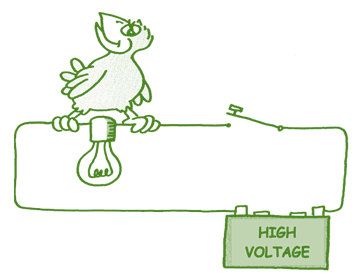In order for you to gain the most value from your qualification and to prepare you for your assessment and the industry, make sure you complete all of the SDL tasks.
Electrical Calculations
Recap the Solving Equations [insert new subtopic number] learning content by visiting this site. Work through the information and attempt the exercises (you may need to click on the various links to find these). The more you practice the better you will become at calculating electrical values.
Conductors, Insulators, Semiconductors and Resistors
- Describe, on a piece of paper, the difference between a conductor and an insulator, in terms of movement of charge.
- Try the 10-question quiz about conductors and insulators here.
- Write answers to these questions without referring to your notes or copying information from another source. They are designed to test your understanding of the three concepts – voltage, current and resistance. Bring your ideas to the face-to-face session to discuss with your tutor and classmates.
- Describe what “electricity” is, in your own words.
- Explain what the electrical terms voltage, current and resistance mean in your own words.
- Voltage is also known by another name: electromotive force or EMF. What this other name for voltage means.
- Is it possible to have a condition where an electrical voltage exists, but no electric current exists? Or the opposite - where an electric current exists without an accompanying voltage? Explain your answers.
- What could you do to a closed circuit consisting of a battery, light bulb and a switch that would increase the amount of current? Explain your answer.
- Describe what you could do to the wire used in a circuit to decrease the amount of resistance presented by the wire.
- If the switch is closed, what will happen to the bird? Explain your answer.
- Construct your own lemon battery. (Talk to your tutor about the components you will need for this.)
- Using a multimeter, measure the voltage of your lemon battery in volts (V).
- Using a multimeter, measure the current your lemon battery produces in amps (A).
- Using the following equation, calculate the Power output of your lemon battery (in watts, W). voltage x current = power
- A cell phone uses about 1.5 W when in talk mode. How many lemon batteries would we need to power a cell phone?
- A laptop uses around 25 W when in use. How many lemon batteries would we need to power that?
- The Chevy Volt batteries can supply 30,000 W. How many lemon batteries would be needed to deliver that power?

Electromagnetic Theory
Answer the following questions about transformers based on today’s lesson.
- In your own words explain what a transformer does.
- What are the parts of a transformer?
- Where are transformers used?
- What do we call a transformer that increases voltage?
- What do we call a transformer that decreases voltage?
- Draw the following table on a piece of paper and match the numbers to the correct labels:

Term Output current Input current Primary coil Secondary coil Number - Draw the correct (circuit diagram) symbol for the step-up transformer:

- Explain how an electric transformer changes the voltage of an electric current.
- Why does a transformer only work with Alternating Current?
DC (Direct Current) Circuits
1. In this exercise you are to calculate the cost-effectiveness of using a LED bulb in place of an incandescent bulb for one year.
A 100-W incandescent light bulb is typically replaced by a 20-W LED bulb. (They provide the same amount of light output.) Assume the bulb is turned on for 3 hours per day and the average energy rate charged by the power company is 20.1c /kWh.
Strategy:
- Calculate the energy used during the year for each bulb using Energy = P x t
- Multiply the energy used by the cost charged by the power company.
- Comment on which bulb is the cheapest for the year.
A 100-W incandescent light bulb costs about $1.50 and has a lifespan of around 1200 hours. A 20-W LED light bulb costs about $22 and has a lifespan of around 50,000 hours.
- How long would you expect each light bulb to last if it is turned on for 3 hours per day?
- How would this information about cost and lifespan affect your choice of light bulb?
2. Visit the Virtual Lab site again and build the circuits according to the instructions provided. Refer to today’s lesson about how to connect ammeters in a circuit.
Connecting an Ammeter:
Ammeters are wired “in series” with the light bulb in a circuit. Be sure to connect the ammeter so that current enters (one of) the + / red terminals and exits the –/black terminal to the rest of the circuit.
Build the circuit shown. The ammeter will be placed in the circuit at 3 different points: A, B and C.
To measure the current at point A, connect the ammeter "in series" with the light bulb as shown. Measure IA, (currently leaving the battery and entering the ammeter). Repeat at points B and C.
IA =
IB =
IC =
Take and record current measurements for the circuit series at the lettered points.
IA =
IB =
IC =
How are IA, IB, and IC related in this circuit?
- How is the brightness of the bulb related to the current flowing?
- What can you say about the current flowing through each bulb in a series circuit?
- Measure and record the current for the parallel circuit shown at 3 different points: A, B and C. Connecting the ammeter at points B and C can be confusing so double-check you have done this correctly.
IA =
IB =
IC =
- How does the current through the two bulbs in the parallel circuit compare?
- What is the mathematical relationship between Ia, Ib, and Ic?
- Explain what is happening to the current as it travels around this circuit.
- If a bulb is not glowing, does that mean there must necessarily be no current flowing? Explain.
- Does the mathematical relationship between Ia, Ib, and Ic that you suggested above, still work for this circuit?
Electronic Components
1. Find out why silicon is the most popular semiconductor material for various applications in modern technology. List at least four different reasons.
2. During your workshop sessions you will practice soldering components to printed circuit boards.
Create a video demonstration showcasing your soldering and desoldering skills for electronic components on PCBs. Provide a voice-over narration to explain the tools used and the steps taken during the process.
- Start recording the video, positioning the camera or smartphone to capture a clear view of the soldering area.
- Begin the narration by introducing the tools and materials you will be using.
- Explain the purpose and function of each tool as you demonstrate their usage.
- Show the proper techniques for soldering electronic components onto the PCB, including:
- Preparing the soldering iron by heating it to the appropriate temperature.
- Applying flux (if desired) to enhance solder flow and improve joint quality.
- Tinning the soldering iron tip by melting a small amount of solder onto it.
- Positioning the component correctly on the PCB and heating the joint with the soldering iron.
- Applying solder to the joint and ensuring good wetting and connection.
- Demonstrating the removal of excess solder and inspecting the solder joint for quality.
- Emphasise the safety precautions taken.
- Edit the video if needed to improve the narration or visual presentation.
- Share the video on the forum for feedback.
- Engage in discussions with your peers by providing constructive feedback on their soldering techniques.
Glossary
The following worksheet contains a list of words taken from this resource. To help improve your understanding, research their meanings or find the definitions in the workbook. There is space to write the definitions. You could also look up how to say the word – most online dictionaries will demonstrate this.
UP Education:
© UP Education Online Pty Ltd [year of course creation]
Except as permitted by the copyright law applicable to you, you may not reproduce or communicate any of the content on this website, including files downloadable from this website, without the permission of the copyright owner.
Copyright Agency License:
WARNING
This material has been reproduced and communicated to you by or on behalf of UP Education in accordance with section 113P of the Copyright Act 1968 (the Act).
The material in this communication may be subject to copyright under the Act. Any further reproduction or communication of this material by you may be the subject of copyright protection under the Act.
Do not remove this notice.
H5P Licence
Activity software obtained under the MIT License
Copyright (c) 2016 Joubel AS
Permission is hereby granted, free of charge, to any person obtaining a copy of this software and associated documentation files (the "Software"), to deal in the Software without restriction, including without limitation the rights to use, copy, modify, merge, publish, distribute, sublicense, and/or sell copies of the Software, and to permit persons to whom the Software is furnished to do so, subject to the following conditions:
The above copyright notice and this permission notice shall be included in all copies or substantial portions of the Software.
THE SOFTWARE IS PROVIDED "AS IS", WITHOUT WARRANTY OF ANY KIND, EXPRESS OR IMPLIED, INCLUDING BUT NOT LIMITED TO THE WARRANTIES OF MERCHANTABILITY, FITNESS FOR A PARTICULAR PURPOSE AND NONINFRINGEMENT. IN NO EVENT SHALL THE AUTHORS OR COPYRIGHT HOLDERS BE LIABLE FOR ANY CLAIM, DAMAGES OR OTHER LIABILITY, WHETHER IN AN ACTION OF CONTRACT, TORT OR OTHERWISE, ARISING FROM, OUT OF OR IN CONNECTION WITH THE SOFTWARE OR THE USE OR OTHER DEALINGS IN THE SOFTWARE.
Reference List:
- alexgeekcouk. (2010, November 18). Transformer Animation. [Video]. YouTube. https://youtu.be/VucsoEhB0NA
- Algebra Basics. (2015, May 23). Solving Basic Equations – Part 1. [Video]. YouTube. https://youtu.be/l3XzepN03KQ
- Algebra Basics. (2015, May 23). Solving Basic Equations – Part 2. [Video]. YouTube. https://youtu.be/Qyd_v3DGzTM
- Algebra Basics. (2015, May 23). What Is Algebra? [Video]. YouTube. https://youtu.be/NybHckSEQBI
- BBC Bitesize. (n.d.) Conductors and insulators. https://www.bbc.co.uk/bitesize/guides/z48gmfr/test
- BCHydro - Powersmart for Schools. ( n.d.) Ohm's Law Explained. https://vimeo.com/560047171/9c76398224
- Beaty, W. (2007, November 8). Simple generator: AC electric generator for science fair. [Video]. YouTube. https://youtu.be/k7Sz8oT8ou0
- Brain, M. & Hall-Geisler, K. (2021, October 5). How Electric Motors Work. How Stuff Works. https://electronics.howstuffworks.com/motor.htm
- Brain, M. & Pollette, C. (2021, September 7). How Electromagnets Motors Work. How Stuff Works. https://science.howstuffworks.com/electromagnet.htm
- Brennan, E. (2021, October 21). How to Use a Multimeter to Measure Voltage, Current and Resistance. https://medium.com/eugenes-diy-den/how-to-use-a-multimeter-to-measure-voltage-current-and-resistance-962bb2931799
- Casio Calculator Tutorial. (2015, February 20).Overview of Essential Buttons (fx-83GT PLUS, fx-85GT PLUS, fx-300ES). [Video]. YouTube. https://youtu.be/rn-XjUVJtyw
- CHMnanoed. (2010, January 16). Magnetism: Motors and Generators. [Video]. YouTube. https://youtu.be/d_aTC0iKO68
- Chrvoje engineering. (2020, June 20). Working Principle of AC Generator! [Video]. YouTube. https://youtu.be/YkHhFho6L2Y
- CK-12 Interactives. (n.d.) Transformer simulation. https://interactives.ck12.org/simulations/physics/ac-transformer/app/index.html?screen=sandbox&hash=f0b5086c59b6e55620f0b4dee95ba2bb&source=ck12&artifactID=1916732
- CK-12. (2017, September 27). Generating and Using Electricity. https://www.ck12.org/section/generating-and-using-electricity/
- Csanyi, E. (2016, August 15). Basic Measuring of resistance, voltage and current using digital multimeter. https://electrical-engineering-portal.com/measuring-resistance-voltage-current-digital-multimeter
- Cyberphysics.co.uk. (n.d.) KS3: Magnetism Questions. https://www.cyberphysics.co.uk/Q&A/KS3/magnetism/A3.html
- Don’t Memorise. (2018, October 23). Physics: Magnetic Force and Magnetic Field. [Video]. YouTube. https://youtu.be/R4ht2RcWVlI
- Don’t Memorise. (2018, September 12). Electricity and Circuits: How does an Electric Bell work? [Video]. YouTube. https://youtu.be/nygn7wB7658
- Eaton Videos. (2020, July 22). Power Generation. [Video]. YouTube. https://youtu.be/ZSCEfJ4TXW4
- Electrical Technology. (2012). Difference Between AC and DC Generator. https://www.electricaltechnology.org/2020/06/difference-between-ac-dc-generator.html
- Electrical Technology. (2021). Basic Electrical Engineering Formulas and Equations. https://www.electricaltechnology.org/2020/10/electrical-engineering-formulas.html
- Electrical4U. (2020, October, 28). Working Principle of Alternator. https://www.electrical4u.com/working-principle-of-alternator/
- Electronics Tutorials. (2010, November 5). [Video]. YouTube. https://youtu.be/tM5js2g1_HY
- Electronics tutorials. AC Waveform and AC Circuit Theory. https://www.electronics-tutorials.ws/accircuits/ac-waveform.html
- Energy Education. (n.d.) Energy vs power. https://energyeducation.ca/encyclopedia/Energy_vs_power
- Flexbooks. (2019, May 30). CK-12 Physical Science for Middle School. Electromagnetic Devices. https://flexbooks.ck12.org/cbook/ck-12-middle-school-physical-science-flexbook-2.0/section/22.5/primary/lesson/electromagnetic-devices-ms-ps/#x-ck12-TVNfUFMtTW90b
- FuseSchool – Global Education. (2020, August 10). Physics: Magnetism. Field Lines. [Video]. YouTube. https://youtu.be/SCnGfE7qxHc
- GCSE Physics. (2020, April 5). Electricity. Conventional Current VS Electron Flow. https://youtu.be/T7GfoBimQ3A
- GGHS Chemistry. (2018, February 3). How to use your calculator for scientific notation. Unit 8: General How-to Videos for Significant Figures, Scientific Notation and Rounding. [Video]. YouTube. https://youtu.be/FyZBLnp4_SI
- Iken Edu. (2016, March 22). Secondary Science: What is Electromagnetic Induction? | Faraday's Laws and Lenz Law. [Video]. YouTube. https://youtu.be/3HyORmBip-w
- Instrumentation & Control. (2021, January 5). What Is OHMS Law ? [Explained in Under 5 Minutes]. [Video]. YouTube. https://youtu.be/uZ-m91IEkjQ
- Instrumentationtools.com. (n.d.) Developing a Sine Wave. https://instrumentationtools.com/wpcontent/uploads/2018/07/Developing-a-Sine-Wave-Voltage-of-Motor.png?ezimgfmt=ng:webp/ngcb2
- IOP - Institute of Physics. (n.d.) Magnetism & electromagnetism PPT.
- Jia, D. (2022, August 27). How to Use a Calculator. https://www.wikihow.com/Use-a-Calculator
- Joe Robinson Training. (2019, October 4). What is Electricity? Part 3: Which Way Do Electrons Flow? [Video]. YouTube. https://youtu.be/9p7XUAcdXIY
- Joe Robinson Training. (2020, February 19). AC Theory: The Mystery of the Coil. [Video]. YouTube. https://youtu.be/LXpXDga-7xM
- Joe Robinson Training. (2020, March 18). How to Calculate Power in an Electrical Circuit, Where Does the Power Formula Come From? [Video]. YouTube. https://youtu.be/xqanURIKnng
- Joe Robinson Training. (2020, March 18). How to Find the Power Formula Number 2 for Electrical Circuits, Calculating Power Without Voltage. [Video]. YouTube. https://youtu.be/lPfu-QpFnS8
- Joe Robinson Training. (2020, March 25). How to Find the Power Formula Number 3 for Electrical Circuits, Calculating Power Without Current. [Video]. YouTube. https://youtu.be/VX1P957sbGU
- Joe Robinson Training. (2020, March 8). How to Calculate Power in an Electrical Circuit, Where Does the Power Formula Come From? [Video]. YouTube. https://youtu.be/9omx07AKH5Q
- Joe Robinson Training. EAL Electrical Science & Principles Level 2 Revision. (2019, October 4). What is Electricity? Part Three: Which way do electrons flow? [Video]. YouTube. https://youtu.be/2ZlfXE_PZOQ
- Joe Robinson Training. EAL Electrical Science & Principles Level 2 Revision. (2019, February 27). What is Electricity? Part Two: The Atomic Structure of Copper. [Video]. YouTube. https://youtu.be/XBJQ_JfJ57Y
- Joe Robinson Training. EAL Electrical Science & Principles Level 2 Revision. (2018, October 30). What is Electricity? Part One: The Structure of an Atom. [Video]. YouTube. https://youtu.be/XBJQ_JfJ57Y
- KQED. (2020, May 5). Slide Energy. [Video]. YouTube. https://youtu.be/1GDsb_kJR20
- Manocha Academy. (2019, July 22). Magnetism. [Video]. YouTube. https://youtu.be/bBKYZFtcWHc
- Manocha Academy. (2020, March 2). Magnetic Effect of Electric Current. [Video]. YouTube. https://youtu.be/v7hWt9F3WcY
- Maribel, M. (2020, August 11). The Math You’ll Use in Chemistry. (First 5 minutes only.) [Video]. YouTube. https://youtu.be/B2EnaKgF08M
- National STEM Centre. (2015, January 17). Static Electricity Demonstration - The Electric Sausage. [Video]. YouTube. https://youtu.be/CHGaMutanKE
- Science Bits. (2015, March 20). Video Lab: Magnetic forces. [Video]. YouTube. https://youtu.be/Mp0Bu75MSj8
- Science Shorts. (2017, January 27). Magnetic Fields, Flux Density & Motor Effect - GCSE & A-level Physics. [Video]. YouTube. https://youtu.be/o0yfYTtR6go
- Seeker. (n.d.) Inside The World's Largest Particle Accelerator. [Video]. YouTube. https://youtu.be/328pw5Taeg0
- Shenoy, M. (n.d.) Electric power & energy. Khan Academy. [Video]. YouTube. https://youtu.be/p1XG7LopGkg
- Spark Fun Electronics. (2016, November 2). Adventures in Science. Electric Power. [Video]. YouTube. https://youtu.be/p8JQTLkV5C8
- Spark Fun Electronics. (2016, October 12). Adventures in Science. What is Voltage? [Video]. YouTube. https://youtu.be/z8qfhFXjsrw
- Spark Fun Electronics. (2016, October 19). Adventures in Science. What is Electric Current? [Video]. YouTube. https://youtu.be/kYwNj9uauJ4
- Spark Fun Electronics. (2016, October 26). Adventures in Science. Ohm’s Law. [Video]. YouTube. https://youtu.be/8jB6hDUqN0Y
- Summers, A. (2014, March 1). Transposition of Formulae Part 1. [Video]. YouTube. https://www.tradeskills4u.co.uk
- Summers, A. (2014, March 17). Transposition of Formulae Part 2. [Video]. YouTube. https://www.tradeskills4u.co.uk
- Taylor, C. (n.d.) Electricity Basics. Voltage, Current, Resistance, and Ohm's Law. https://learn.sparkfun.com/tutorials/voltage-current-resistance-and-ohms-law/all
- Technology Student.com. (2002-2022). Test Instruments. https://technologystudent.com/elec1/metre1.htm
- The Physics Classroom. (n.d.) Electricity: Electric Circuits. https://www.physicsclassroom.com/calcpad/circuits/problems
- TutorVista. (2010, April 27). Conductors Insulators and Semi-Conductors. [Video]. YouTube. https://youtu.be/8Pnsbh0DrE4
- W CLN. (2013, April 9). Ohm's Law Experiment. [Video]. YouTube. https://youtu.be/48_CqnhRbww
- Woodward, C. (2021, October 21). Explain that stuff. Electricity. https://www.explainthatstuff.com/electricity.html
